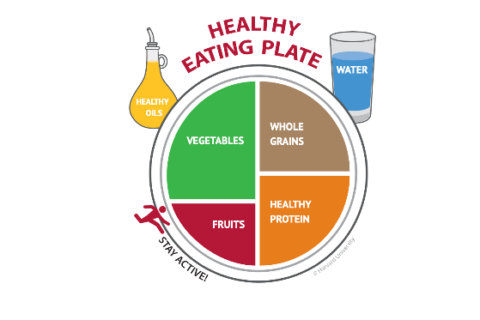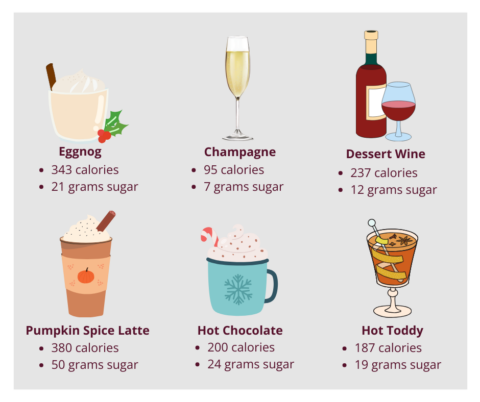Healthy Eating for the Holidays

The holiday season is just around the corner! The hallmark of most American winter holidays are centered around big, indulgent meals; think Thanksgiving Dinners, Friendsgiving Dinners, Christmas Breakfasts, Christmas Dinners and New Year’s Eve parties. Research shows that Americans gain an average of one to three pounds from Thanksgiving to New Year’s Day, which can mean a weight gain of 10-30 pounds per decade. This may not seem like a number to be concerned about; however, this type of weight gain left unchecked can increase the risk of other serious conditions such as type 2 diabetes and hypertension. So how do we balance our holiday eating without wrecking the holiday cheer?
Well, holidays have a pretty simple pattern: we feast, we drink and we sit. We can make small changes in each of these three areas to help our health AND stay in the holiday spirit.
Feasting
First, let’s talk about feasting. There are many ways that we can enjoy our holiday favorites while also avoiding the meat sweats and belly aches. One way is by sticking to the plate model for both partaking in and hosting holiday meals. The plate model is a guide from Harvard’s School of Public Health for creating healthy, balanced and satisfying plates of food. Here are the basics:
- Make most of your meal vegetables and fruits (1/2 of your plate)
- Go for whole grains (1/4 of your plate)
- Protein Power (1/4 of your plate)
- Healthy plant oils (in moderation)
- Drink water, coffee or tea (skip the sugary drinks)

This model can be used in your everyday life and during the holidays, especially when faced with an all-you-can-eat buffet situation. Another strategy for eating during the holidays is to pay attention to your hunger scale. The hunger scale is a scale from 0 (too hungry) to 10 (too full). We are often taught at an early age to ignore our innate hunger and fullness cues to fit our eating into preordained eating times “breakfast, lunch, dinner” which can become even more exaggerated during the holidays. Too often we wait until we are too hungry to eat which leads us to consume food quickly and overeat. We then feel shame so repeat the pattern. Aim to start eating when you are at a three on the scale, consume your food slowly and stop when you are at a seven.

If you are the one hosting holiday meals, there are a few strategies for making it healthy. First, try to fill your table with vegetables. Vegetables are versatile and delicious when prepared properly! You can roast, boil, pickle, slice and dip veggies so don’t be afraid to offer them in abundance. Here are some of Island Health’s favorite fall recipes that spotlight vegetables.
- Curry Roasted Cauliflower
- Warm Dijon French Lentils with Spinach
- Spaghetti Squash with Pesto and Parm
- Farro and Apple Harvest Salad
Building a beautiful veggie tray – 3 steps to making a veggie tray everyone will be talking about!
- Place your sauces on the tray first (bonus points for choosing hummus and Greek yogurt based dips as these have more protein and less sodium than other dips)
- Place cheaper, more abundant items next (carrots, celery, cucumber, broccoli)
- Place fancier items last, focusing on color (peppers, herbs, radishes, jicama)
Adding fiber to your dishes is yet another strategy to increase the nutrition value of your dishes. Fiber helps us to feel more satisfied and helps our body to eliminate some of the added sugar and cholesterol in our atypical holiday eating pattern. You can increase the fiber content of soups and stews by adding lentils and beans. For sweets, don’t be afraid to add some oats or chia seeds!
Drinking
Next, let’s address the eggnog in the room. Often times a holiday meal is not complete without a holiday beverage. There is nothing wrong with one or two drinks to accompany your meal, but be cautious about the sugar and calorie content in many popular drinks. We want to eat our calories, not drink them away!

For reference the American Heart Association recommends a daily intake of sugar as 25 grams per day for women and 36 grams per day for men.
Sitting
Lastly, it is important to aid our holiday digestion through movement! The general guidelines for physical activity is to aim for 150 minutes per week of moderate exercise; however, we need to increase this when we are indulging over the holidays. Try getting in a workout in the morning, before a big holiday party, or going on a group walk after eating. The Italians have a term for this walk after dinner, “passeggiata” which is a gentle and slow stroll as the sun sets.
The holidays are a happy and special time, so try out these strategies to keep your tummy happy too!
